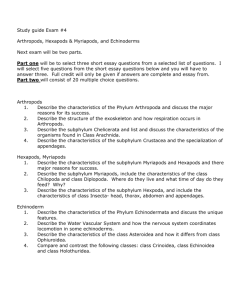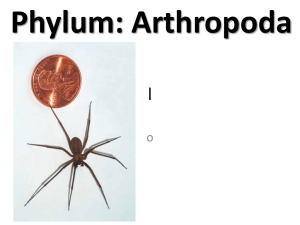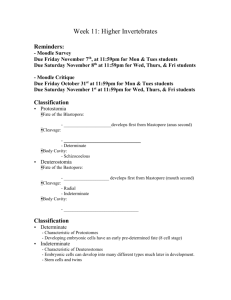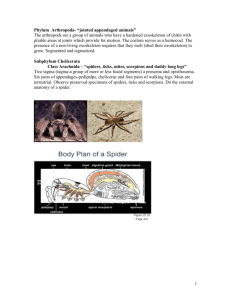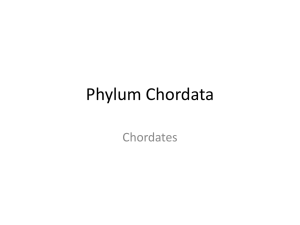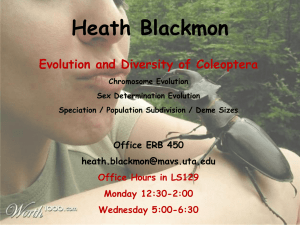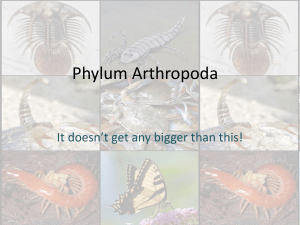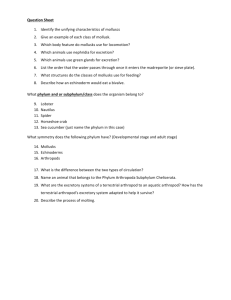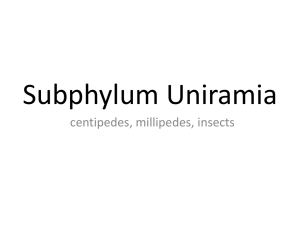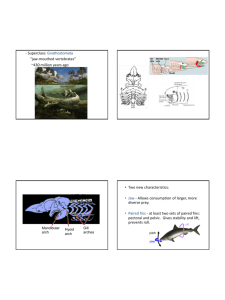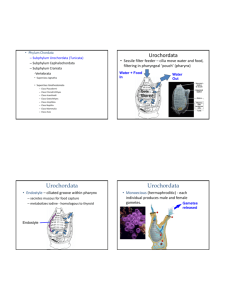Animal Diversity II - School of Biological Sciences
advertisement
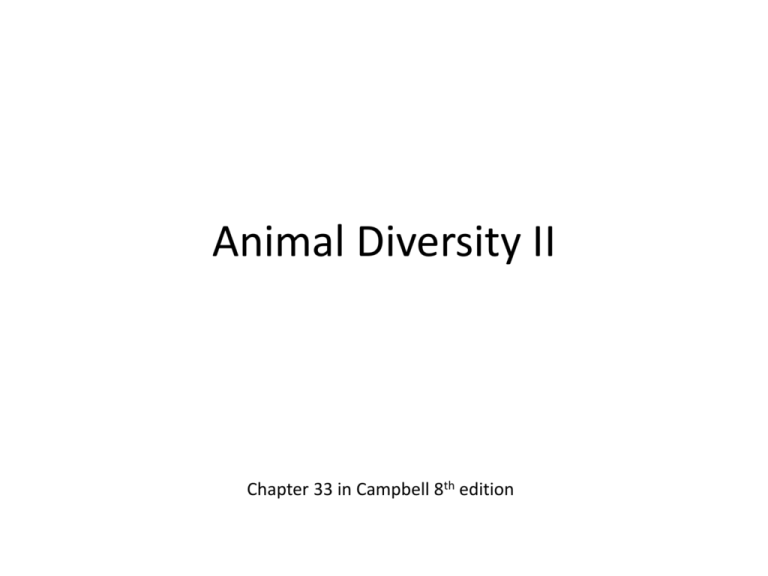
Animal Diversity II Chapter 33 in Campbell 8th edition Evolutionary Relationships Symmetry Symmetry http://www.millerandlevine.com/ques/symmetry.html Body Cavities -Protostome-blastopore becomes mouth - Ecdysozoa-things that shed an exoskeleton through ecdysis-arthropods and nematodes - Lophotrochozoa-Larval stage called a trocophore larvae or have a feeding structure called a lophophore Phylum Annelida General Characteristics of Annelida: “Annelida” – “little ring” Segmented Coelom – fluid filled body cavity Marine, freshwater, and damp soils Concept 33.3 in Campbell 8th edition http://andrerossanez.blogspot.com/2008/03/annelida.html http://www.cartage.org.lb/en/themes/science s/zoology/animalclassification/Polygenetic/ph ylogenetictree/Annelida/Annelida.htm http://museumvictoria.com.au/learning-federation/infosheets/insects/psyllids-on-wattle-plants10/ Phylum Annelida 3 groups (classes): Subclass Oligochaeta (oligos – few, chaite – long hair) Class Polychaeta (poly – many, chaite – long hair) Class Hirudinida Subclass Oligochaeta “few bristles” Sparse bristles on each segment – chaeta – chitin Freshwater & terrestrial http://biology.unm.edu/ccouncil/Biology_203/Summaries/Protostomes.htm http://etc.usf.edu/clipart/6900/6940/earthworm_6940.htm Class Polychaeta “many bristles” Pair of parapodia on each segment with many chaeta – chitin Rich and diverse Mostly marine http://reefkeeping.com/issues/2003-03/rs/index.php Photos courtesy of Dr. Raymond Lee of WSU Class Hirudinida Mostly fresh water – some are terrestrial Predatory – some are parasitic Sucking mouth parts No chaeta Have been used for medicinal purposes http://www.dhammawheel.com/viewtopic.php?f=31&t= 4026 http://kimlong9999.blogspot.com/2010/07 /con-ia.html Phylum Arthropoda General Characteristics of Arthropoda: Largest and most diverse than all other animal phyla combined Water, Land, and Air – Herbivore, Carnivore, and Parasites Body completely covered by the cuticle – exoskeleton made of layers of protein and chitin Well developed sensory organs Open circulatory system Jointed appendages Phylum Arthropoda 4 extant groups (Subphyla): Subphylum Chelicerata (cheir – arm) Subphylum Crustacea (crusta – shell) Subphylum Hexapoda (hex – 6 , pod – foot/leg) Subphylum Myriapoda (myriad – many , pod – foot/leg) including the extinct Subphylum Trilobita Subphylum Chelicerata (cheir – arm) mouth parts pointed mouth part appendages which are used to grasp food Can be hollow and contain (or are connected to) venom glands, and are used to inject venom http://webs.lander.edu/rsfox/invertebrates/anoplodactylus.html http://commons.wikimedia.org/wiki/File:Lasiodora_parahybana,_chelicerae.JPG Subphylum Chelicerata 2 body segments: Abdomen Cephalothorax spiders, scorpions, horseshoe crab http://www.amnh.org/learn/biodiversity_counts/ident_help/Parts_Arthropods/male_spider.htm Subphylum Crustacea Highly specialized appendages Marine and freshwater http://uh.edu/engines/epi1948.htm Subphylum Hexapoda (greek hex – six, podos – foot) Insects - 3 body regions-head, thorax, abdomen http://computerkiddoswiki.pbworks.com/Insects Subphylum Myriapoda Millipedes Centipedes Photo by Jason Diltz All terrestrial Have mandibles Head has pair antennae and 3 pair of appendages as mouthparts Subphylum Myriapoda Millipedes have 2 pair legs per body segment http://www.uptake.co.nz/resources/soil_biology_primer/soil_biology_primer_08.html Centipedes have 1 pair legs per body segment http://www.geol.umd.edu/~tholtz/G331/lectures/331arthr.html#next7 Subphylum Trilobita Cambrian Seas – 525 mya were around for over 200 million years http://www1.newark.ohiostate.edu/Professional/OSU/Faculty/jstjohn/ Cool%20Fossils/Elrathia%20with%20bite%20 mark.htm Lab Exercises Annelida Exercise 1 – various Annelids – No dissection Exercise 2 & 8 – Polychaeta – examination – Dr. Lee Exercise 3 – Oligochaeta - observation of live worms Exercise 4 & 5 – Oligochaeta - worm dissection Exercise 6 – prepped slides – Lumbricus Exercise 7 – examination Hirudinia – leeches Exercise 8 – Strange polychaetes Exercise 9 – Unknown polychaetes, what family are they from? Arthropoda Exercise 1 – Limulus - horseshoe crab No dissection Exercise 2 – Trilobites – fossil examination Exercise 3 – preserved crayfish – external – can dissect Exercise 4 – Preserved grasshoppers - external – can dissect Marine aquarium – hermit crabs, shrimp, sea cucumbers, sea stars, brittle stars, urchins Dissections • The cold saltwater tank in lab contains examples from some of the groups studied in lab • DO NOT START CUTTING UP SAMPLES WILLY NILLY !!! • Clam and squid dissections - instruments, pans, gloves, and disposal container for dissection remains are on the side bench at the back of the room. • Please try to keep this area reasonably organized • Wash/rinse the instruments and pans after use • Make sure You dispose of dissection remains in the labeled container - NOT in the trash! Cool Links Images and video of Axial Volcano http://www.pmel.noaa.gov/vents/nemo/ A polychaete family key is available on the internet: http://www.nhm.ac.uk/researchcuration/research/projects/taxinfo/key/family_key.htm Drawings of each family are shown at: http://www.nhm.ac.uk/researchcuration/ research/projects/taxinfo/browse/family/family_browser.htm Next Week Animal Diversity III
